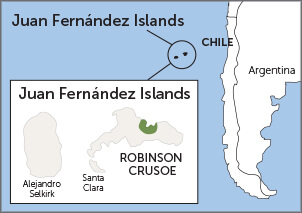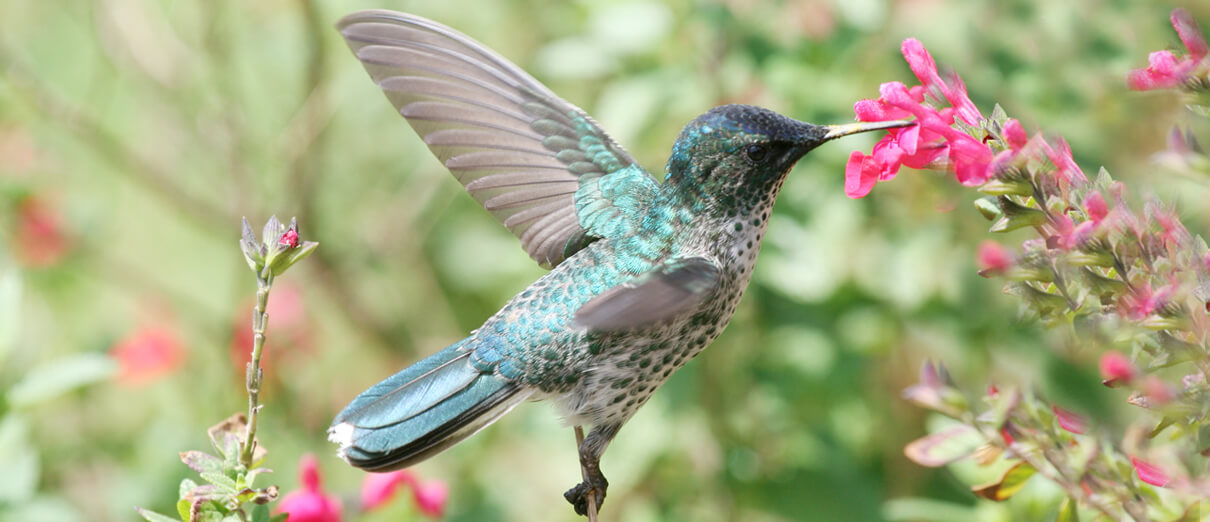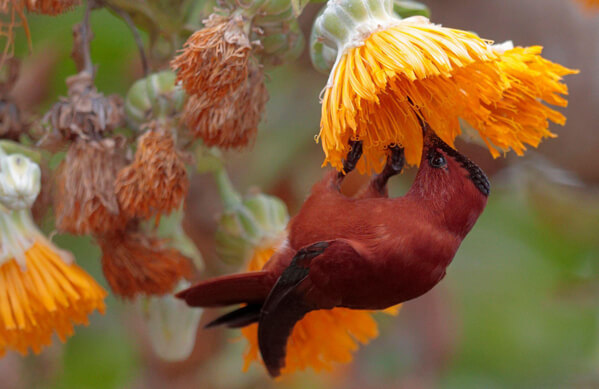
Juan Fernández Firecrown range map by American Bird Conservancy
The beautiful Juan Fernández Firecrown is surely one of the world's most isolated hummingbird species. Unlike mainland birds such as the Chilean Woodstar, this hummingbird is found on just one far-flung Pacific island in Chile's remote Juan Fernández Archipelago, more than 370 miles west of the South American mainland. That island, Isla Robinson Crusoe, has been designated an Alliance for Zero Extinction site because it contains this species' entire global population.
Equally Eye-Catching
Picture yourself birding on Isla Robinson Crusoe, looking for the island's two hummingbird species. You spot the small, drab Green-backed Firecrown first. But then you face an identification conundrum: Two gaudy, larger birds appear, one green and white, the other orange. As it turns out, female and male Juan Fernández Firecrowns look completely different — so much so that they were once considered separate species!
The female Juan Fernández Firecrown may not be quite as flashy as the male, but she is still a brilliant dark green above and white below, spangled with iridescent green spots, and topped with an iridescent blue-green crown. (See photo below.) In contrast, the male is a uniform rufous-orange, with a fiery reddish-yellow crown.
The striking difference in plumage between males and females, known as sexual dimorphism, is seen in a variety of other bird species, ranging from the Wood Duck to the Black-throated Blue Warbler. The majority of hummingbird species exhibit different female and male plumages, with the Juan Fernández Firecrown providing a dramatic example.
In the case of the firecrown, researchers speculate that sexual dimorphism may have evolved to minimize intersexual competition in a resource-limited, species-poor environment. Interestingly, there is currently a heavily skewed sex ratio within this population, with three males to every female. Researchers are not sure if this disparate sex ratio is natural or a consequence of population decline and habitat loss. As you will read below, though, females do seem to face a threat that males likely do not.
Flashy Flower Defender
Another race of Juan Fernández Firecrown once occurred on Isla Alejandro Selkirk in the same archipelago, but it went extinct there early in the 20th century. Females of the remaining race on Isla Robinson Crusoe face competition for food and habitat from their smaller, increasing relative, the Green-backed Firecrown. Interestingly, this smaller species has a far smaller body, but a bill about the same size as its dwindling neighbor. Male Juan Fernández Firecrowns do not seem to be impacted by this competition, likely because they are larger.
The Juan Fernández Firecrown aggressively defends favored patches of flowers, vocalizing while it hovers in front of an intruder and flashing its colorful crown. Listen to its shrill, sputtering call:
(Audio: Juan Fernández Firecrown by Fabrice Schmitt, XC380081. Accessible at www.xeno-canto.org/380081.)
Hummingbird Habits
This hummingbird feeds on nectar from a variety of plants, both those found only on Isla Robinson Crusoe and some introduced from elsewhere. Like the Marvelous Spatuletail, Glittering Starfrontlet, and other hummingbirds, it also eats insects, particularly during nesting season, when extra protein is needed both to fuel fast-growing young and their high-performance parents.
At about 5 inches long, Juan Fernández Firecrowns are rather large hummingbirds. (By contrast, the Ruby-throated Hummingbird measures 3.75 inches.) They frequently hang from flowers, gripping with their strong feet rather than hovering — a practical and energy-saving adaptation for a bird living on a windswept island. Unfortunately, this behavior may make them more vulnerable to predation by introduced cats.

Female Juan Fernández Firecrown by Fabrice Schmitt
Safeguarding the Rarest
The decline of the Juan Fernández Firecrown is due to habitat degradation caused by invasive plants, especially introduced blackberry shrubs that overwhelm native plants, and herbivores, particularly rabbits, but also goats, that chew down tree saplings and other vegetation. Other invasive species such as cats, rats, mice, and coatis also pose problems.
Preventing this species' extinction is a priority for ABC and our partners. We have supported the work of partner Oikonos to protect the firecrown through invasive plant control, critical habitat restoration, and management of nonnative predators. Oikonos has also worked with teams of veterinarians from Chilean universities to spay and neuter pet cats, and initiate a pet registry to more easily distinguish between household and feral cats.
ABC is currently fundraising to save rare hummingbirds including the Juan Fernández Firecrown, as well as other declining species such as the Blue-throated Hillstar and Gray-bellied Comet.
Donate today to help save hummingbirds and their habitats throughout the Americas!



















































